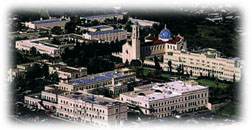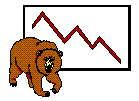

  |
| March
13, 2003 – Problems with the timely receipt of data have prevented
the release of the University of San Diego’s Index of Leading
Economic Indicators for San Diego County since October of 2002.
This report updates the Index through the end of 2002.
More timely reports will be released as the data becomes
available.
With declines in each month from September to December of 2002, the USD Index of Leading Economic Indicators has fallen for nine months in a row. As a result, the outlook for the local economy remains negative in the short term. While a decrease in economic activity is unlikely (see below), any growth in the economy of San Diego is likely to be sluggish in the year ahead. Job growth for 2003 is projected in the 10,000 – 15,000 range, up slightly from the 9,500 jobs gained in 2002, which was the smallest number of jobs gained in the region since 1994. Without strong job growth, the local unemployment rate will remain higher than in recent years, in the 4.0 – 4.5% range. |
|
| September | October | November | December | ||
 |
Index of Leading Economic
Indicators The index for San Diego County that includes the components listed below Source: University of San Diego |
- 0.9% | - 0.9% | - 0.3% | - 0.5% |
 |
Building Permits
Residential units authorized by building permits in San Diego County Source: Construction Industry Research Board |
- 0.20% | 0.21% | 1.34% | 0.55% |
 |
Unemployment Insurance
Initial claims for unemployment insurance in San Diego County, inverted Source: Employment Development Department |
- 1.29% | - 1.13% | 0.27% | 1.21% |
 |
Stock Prices San Diego Stock Exchange Index Source: San Diego Daily Transcript |
- 0.66% | - 0.46% | 1.41% | 0.06% |
 |
Consumer Confidence
An index of consumer confidence in San Diego County Source: San Diego Union-Tribune |
- 2.05% | - 3.79% | - 4.85% | - 3.84% |
 |
Help Wanted Advertising
An index of help wanted advertising in the San Diego Union-Tribune Source: Greater San Diego Chamber of Commerce |
- 0.22% | - 0.79% | - 1.07% | - 1.13% |
 |
National Economy
Index of Leading Economic Indicators Source: The Conference Board |
- 0.82% | 0.33% | 0.98% | 0.16% |
Although
nine consecutive monthly declines in a leading economic indicators index would
normally signal an upcoming recession, the structure of the San Diego economy
protects it somewhat from the normal swings of the national business cycle.
There are not a lot of companies locally that manufacture cyclical
products such as automobiles, appliances, and steel which would be adversely
affected by inventory buildup and subsequent layoffs during a downturn in the
business cycle. Also, because there
are not a lot of big corporate headquarters here, the region is less affected by
the mass layoffs that often occur in middle management during difficult economic
times. Thus, a “recession” in
San Diego might be defined as positive but slower economic growth as opposed to
strong growth during good economic times. It
would probably take a strong outside shock, such as a prolonged military
conflict or terrorist activity, for there to be an actual decline in the local
economy.
| Index | % Change | ||
| 2001 | DEC | 137.3 | +0.4% |
| 2002 | JAN | 137.8 | +0.3% |
| FEB | 138.2 | +0.3% | |
| MAR | 138.8 | +0.5% | |
| APR | 138.5 | -0.2% | |
| MAY | 138.3 | -0.2% | |
| JUN | 137.5 | -0.5% | |
| JUL | 136.5 | -0.7% | |
| AUG | 135.6 | -0.7% | |
| SEP | 134.4 | -0.9% | |
| OCT | 133.1 | -0.9% | |
| NOV | 132.7 | -0.3% | |
| DEC | 132.1 | -0.5% |

For more information on the University of San Diego's Index of Leading Economic Indicators, please contact:
| Professor Alan Gin
School of Business Administration University of San Diego 5998 Alcalá Park San Diego, CA 92110 |
TEL: (619) 260-4883 FAX: (858) 484-5304 E-mail: agin@san.rr.com |